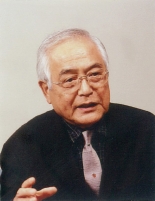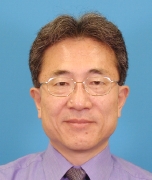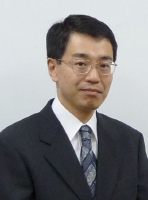Congress
Invited Speakers
These three invited speakers were selected as they are closely related to the theme of 18th ICDMFR “Radiation and Peace”.
 Mr.Takashi Hiraoka is the former City Mayor of Hiroshima. He was born in 1927 and graduated from the School of Letters, Arts and Sciences I,Waseda University in 1952. He started to work as a journalist in the Chugoku Shimbun (Hiroshima’s Local Newspaper) and later became the editor. Then he moved to the RCC Broadcasting Co. Ltd. as its president. In 1991 he became the City Mayor of Hiroshima, a post he held for 8 years.
Mr.Takashi Hiraoka is the former City Mayor of Hiroshima. He was born in 1927 and graduated from the School of Letters, Arts and Sciences I,Waseda University in 1952. He started to work as a journalist in the Chugoku Shimbun (Hiroshima’s Local Newspaper) and later became the editor. Then he moved to the RCC Broadcasting Co. Ltd. as its president. In 1991 he became the City Mayor of Hiroshima, a post he held for 8 years.
He registered the atomic-dome as a world heritage site. Further, he supported activities of Hiroshima exposed people including Koreans, and has continued to support the atomic-bomb survivors. In 1995, he called for a response from people around the world to support the illegality of nuclear weapons. This was in spite of Japanese government’s reluctance to support nuclear disarmament in the International Court of Justice, During his term as City Mayor of Hiroshima, he continually appealed for world peace.
He now works as the executive head of some local Organization. He also supports people such as those in the Kazakhstan and Semipalatinsk areas who were exposed by nuclear experiments in the Soviet Union.
His lecture will be an appeal for peace from Hiroshima.
The other two invited speakers are from the Radiation Effect Research Foundation Hiroshima (RERF). This institute was previously called Atomic Bomb Casualty Commission (ABCC). They are Dr. Nori Nakamura and Dr. Kotaro Ozasa who will give reports on long term health effects of the atomic bombs that fell on Hiroshima and Nagasaki.
 Dr. Nori Nakamura graduated from the Osaka University Engineering School (1969), then changed the direction of his studies to Drosophila genetics at the Hiroshima University Faculty of Sciences. After obtaining a PhD degree (Doctorat d’Université) at Paris University South (Orsay) in Genetics in 1973, he became a research fellow at the Department of Radiation Biophysics at University of Tokyo Medical School (1974-1984) and studied radiation mutagenesis in cultured mammalian cells. In 1984, he moved to the Radiation Effects Research Foundation, a cooperative Japan-US research organization for studying late effects of exposure to atomic-bomb radiation. He has studied the inter-individual variation in radiation sensitivity, somatic mutations in blood cells, chromosome aberrations in blood lymphocytes of atomic-bomb survivors, and biological dose evaluation by electron spin (paramagnetic) resonance (ESR, EPR) method, using tooth enamel. He is currently a member of ICRP Committee 1.
Dr. Nori Nakamura graduated from the Osaka University Engineering School (1969), then changed the direction of his studies to Drosophila genetics at the Hiroshima University Faculty of Sciences. After obtaining a PhD degree (Doctorat d’Université) at Paris University South (Orsay) in Genetics in 1973, he became a research fellow at the Department of Radiation Biophysics at University of Tokyo Medical School (1974-1984) and studied radiation mutagenesis in cultured mammalian cells. In 1984, he moved to the Radiation Effects Research Foundation, a cooperative Japan-US research organization for studying late effects of exposure to atomic-bomb radiation. He has studied the inter-individual variation in radiation sensitivity, somatic mutations in blood cells, chromosome aberrations in blood lymphocytes of atomic-bomb survivors, and biological dose evaluation by electron spin (paramagnetic) resonance (ESR, EPR) method, using tooth enamel. He is currently a member of ICRP Committee 1.
At the 18th ICDMFR, he will present two reports on the outcomes of the atomic bomb survivors in Hiroshima. The abstracts are:
How radiation exposure increased the risk of leukemia among atomic-bomb survivors?
Nori Nakamura (Radiation Effects Research Foundation)
Human leukemia frequently involves recurrent translocations. Since radiation is a well-known inducer of both leukemia and chromosomal translocations, it has long been suspected that radiation might cause leukemia by inducing specific translocations. However, recent studies clearly indicate that spontaneous translocations specific to acute lymphocytic leukemia (ALL) actually occur much more frequently than do actual cases of leukemia, while most of the translocation carriers do not develop the disease. I proposed an alternative hypothesis that the radiation-related ALL risk to a population is mostly attributable to a small number of predisposed individuals in whom relatively large number of translocation-carrying, pre-ALL cells have accumulated. This pre-leukemic clone hypothesis explains various known characteristics of radiation-related ALL. The hypothesis can also be applied to chronic myelogenous leukemia, and to young-at-exposure cases of acute myelogenous leukemia.
Why chromosome aberration in lymphocytes did not persist following fetal exposure?
Nori Nakamura, Mimako Nakano, Yoshiya Shimada, Yoshiaki Kodama (Radiation Effects Research Foundation, Hiroshima, Japan)
Cytogenetic tests of blood lymphocytes from atomic bomb survivors have long been conducted at RERF for better understanding radiation doses received by individual survivors. Curiously, however, those who were exposed to radiation as fetuses (in utero survivors) did not indicate any dose effect when they were examined at about 40 years old, which was quite counterintuitive as fetuses are believed to be hypersensitive to radiation. The results were confirmed by mouse experiments (fetal irradiation and cytogenetic examinations at 20 weeks of age). In addition, we found that irradiated neonates also showed the refractory characteristics in recording radiation effects when examined at 20 weeks of age while mice irradiated at a young age started to record radiation effects with the increase of age at the
time of exposure. Animals irradiated at 6 weeks old or older gave the same results as adults. P53 gene status (and hence P53-dependent apoptosis) did not affect the results. It is reported that a drastic shift of the niche for hematopoietic stem cells (HSCs) occurs at around 3-4 weeks of age from liver to bone marrow, and this transition is accompanied by a sharp increase of ATM gene by 10 to 100 times; that is, the level is very low in HSC in fetal liver and at 3 weeks of age (Bowei et al. 2007). Thus, the DNA repair system is not probably operating in HSC of immature animals and hence chromosome aberrations as a result of mis-repair do not take place. Our preliminary data of mammary epithelial cells in rats showed that mammary gland stem cells in fetuses are not less sensitive than those in adults in recording cytogenetic damage. Therefore, it seem that the fate of cytogenetically aberrant cells in fetuses largely differ depending on the tissue. It is not yet understood the relationship between the fate of cytogenetic damage and cancer risk.
 Kotaro Ozasa, Hiroshima, Japan.
Kotaro Ozasa, Hiroshima, Japan.
Dr.Kotaro Ozasa graduated from Kyoto Prefectural University of Medicine in 1981 and was engaged in epidemiology of cancer and other diseases as well as public health activities as a faculty member of the university, then as an associate professor for over twenty years.
He has been Chief of the Epidemiology Department at the Hiroshima Laboratory of the Radiation Effects Research Foundation since 2008.
He received a Fellowship of the Faculty of Public Health of the Royal College of Physicians of the UK in 2009.
“Epidemiological studies of the late heath effects of atomic-bomb radiation in Hiroshima and Nagasaki”
Abstract
The Atomic Bomb Casualty Commission (ABCC), a cooperative research agency of the US National Academy of Science/National Research Council and the Japanese National Institute of Health of the Ministry of Health and Welfare, started a prospective cohort study in the 1950s called the Life Span Study (LSS) to evaluate the late health effects of atomic-bomb radiation among the survivors of the atomic bombings. In 1975, the ABCC was reorganized as the Radiation Effects Research Foundation (RERF), a private, non-profit foundation funded by the Japanese Ministry of Health, Labor and Welfare and the U.S. Department of Energy, the latter
in part through the National Academy of Sciences. ABCC/RERF research has been in continuous operation since its inception. The initial 120,000 people of LSS have been followed up until death and the cause of death for all subjects and cancer incidence for those living within the catchment areas of the Hiroshima and Nagasaki cancer registries. Around 60% of them died during 1950-2003 and increased the mortality risk of cancer and some non-cancer diseases such as circulatory diseases was observed.
Keynote Speakers
Keynote Speakers will be invited from the early submissions before November 2010. We will contact them before December 2010.
Call for Abstract
Online Submission Procedure
Abstract submission is only possible online at www.iadmfr2011.org.
Please read all instructions before submitting your abstract.
Abstracts should be submitted by the presenting author.
Abstracts should be submitted in English.
Abstracts must be completed according to the prescribed format (see the Sample Abstract).
Graphs, tables, or figures are encouraged in addition to text as long as they are included in the Word document and the total length of the abstract does not exceed one page. Abstract text should be divided into the following sections:- Introduction- Objectives- Materials and methods- Results- Conclusions and discussion for a case report also the format - Introduction, -Case Report, Discussion can be used.
The online abstract submission facility will be available from September 1st, 2010.
CLOSING DATE FOR RECEIPT OF ABSTRACTS: January 15th, 2011.
Written confirmation of abstracts will be sent by email of February 15th, 2011.
The contents of the presentation should be pertinent to Oral and Maxillofacial Radiology. (see also the Congress themes with the topics).
All presenters are required to register for the Congress.
Further instructions are mentioned on the abstract submission form.
Presenting authors should register for the congress no later than March 31st, 2011.
When the author's registration is not confirmed by March 31st, the Organizing Committee will be forced to withdraw the abstract from the official program.
Oral Presentations
Each presenter will be given 12 minutes for the oral presentation followed by 3 minutes for discussion. Further information and guidelines will be included with the notification of acceptance.
Poster Presentations
All posters must be displayed during the entire Congress.
Poster sessions will be held at designated times where authors will have the opportunity to present their work.
Authors must be present at their posters throughout their assigned poster session.
Posters should not be larger than 150 cm in length/height and 90 cm in width
The poster must have the same information as the abstract: Introduction, Objectives, Materials and methods, Results and Conclusions and Discussion
For a case report also the format - Introduction, -Case Report, Discussion can be used.
The following information must appear at the top of the poster:- Title, Name(s) of Author(s), address of author(s), photograph(s) of authors.- The presenter of the poster must be identified with an asterisk.
Poster boards and adhesive materials will be available to delegates to display.
Further information will be included with the notification of acceptance and also made available at this website in due time.
Evaluation
Abstracts will be reviewed by the Program Committee and either selected for oral or poster presentation or rejected.
Sample Abstract
(download Sample Abstract here)
Abstract Submission
The abstract submission procedure is open during September 1st, 2010 to January 15th, 2011. For urgent questions please contact us at 18thicdmfr@iadmfr2011.org .
Congress Themes
- I. Anatomy
- 1. Conventional imaging
- 2. Three-dimensional imaging
- 3. Others
- II. Diagnostics
- 1. Caries
- 2. Endodontics
- 3. Periodontology
- 4. Orthodontics
- 5. TMJ
- 6. Bone tissue changes
- 7. Trauma and root resorption
- 8. Salivary glands
- 9. Implants
- 10. Forensic
- 11. Decision making
- 12. Others
- III. Imaging Technology
- 1. Intraoral (digital) imaging
- 2. Extraoral (digital) imaging
- 3. Three-dimensional imaging
- a) Cone Beam CT
- b) Micro CT
- c) Medical CT and MRI
- d) other 3D techniques
- 4. Presurgical planning
- 5. Orthodontics/Cephalometry
- 6. Radiology Information system
- 7. Ultrasonography
- 8. Others
- IV. Education
- 1. Undergraduate and graduate education
- 2. Computer-assisted learning
- 3. Others
- V. Radiation
- 1. Dosimetry
- 2. Radiation protection
- 3. Risk assessment
- 4. Radiation biology
- 5. Therapy
- 4. Others
- VI.Miscellaneous
Closed
Research Award (From IADMFR)
Extended Deadline: January 31st, 2011
This award for junior/trainee DentoMaxilloFacial radiologists will be awarded at the 18th congress of the IADMFR in Hiroshima, subject to suitable applications being received. The purpose of this award is to encourage research in maxillofacial imaging and to stimulate interest in the IADMFR.
Criteria
Original research limited to any aspect of maxillofacial imaging will be considered. It will be judged on:
1. Originality and design of the investigation.
2. Quality of the data produced.
3. Suitability of the methods of analysis used.
4. Scientific value of the work.
5. Quality of the presentation.
6. Demonstrated mastery of the subject.
The applicant must state that he / she is prepared to deliver a paper at the Scientific Meeting of the congress should he/she reach the finals of the competition.
Eligibility
The applicant must be a member of the IADMFR and:
1. A postgraduate student in a recognized maxillofacial radiology program or related discipline, such as medical physics, radiation biology, imaging sciences, or engineering.
2. A junior faculty in one of the above programs within 5 years of graduating.
3. A dental student or postgraduate student in another discipline performing research in maxillofacial imaging under the guidance of a dentomaxillofacial radiologist.
The candidate must be nominated for the award by his/her program director (or the dean).
More than one student can be proposed from the same school if the program director / dean deem them eligible. The program director or dean must attest to the status of the contestant.
Award
All the finalists will be required to present their papers (oral presentation) at the Congress in Hiroshima.
The first prize will be: USD 7,500
The second prize will be: USD 2,500
Deadlines
Submission of abstract (to congress): January 31st, 2011 Submission of extended abstract (to editor) : January 31st, 2011
Notification of finalists: February 15th, 2011 (Possibly postponed)
Submission of full-length manuscript (to editor): April 15th, 2011
Presentation by finalists at Congress: May 26th, 2011 All the details on the Award can be found at the IADMFR Web site http://www.iadmfr2011.org
Deadlines 18th Congress Hiroshima, 2011
Submission of abstract: (to Congress) January 31st, 2011
Extended Abstract (to Editor) January 31st, 2011
Notification of finalists February 15th, 2011 (Possibly postponed)
Submission of full-length manuscript (to editor) April 15th, 2011
Presentation by finalists in Hiroshima May 26th, 2011
Information:
Sharon L. Brooks, DDS, MS
Chairman SELECTION COMMITTEE Research Award
Diplomate, American Board of Oral and Maxillofacial Radiology
University of Michigan, School of Dentistry
Ann Arbor, MI 48109-1078 USA
Phone: +1 734-764-1595
Fax: +1734-764-2469
Email: slbrooks@umich.edu
Prof. PARKER Mohamed E.
Secretary General IADMFR
Department of Diagnostics and Radiology
Faculty of Dentistry
University of the Western Cape
Private Bag X1, Tygerberg 7505
SOUTH AFRICA
Phone: 27-21-937 3121
Fax: 27-21-931 2287
Email: meparker@uwc.ac.za
Poster Award (JSOMR President Award)
This award for DentoMaxilloFacial radiologists will be awarded at the 18th congress of the IADMFR in Hiroshima, by the president of the 52nd annual congress of Japanese Society of Oral and Maxillofacial Radiology, subject to suitable applications being received. The purpose of this award is to encourage research in maxillofacial radiology and to stimulate interest in the IADMFR.
Criteria
Poster presentations will be considered. It will be selected by the scientific award committee of JSOMR.
Eligibility
The applicant must be a member of the JSOMR or IADMFR.
Award
The first prize will be: JPY 100,000
The second prize will be: JPY 50,000
What's New
'11.05.16…Final Abstract Book
'11.05.16…Final Program and Schedule
'11.04.14…The early registration is extended to April 25th.
'11.03.31…From the President
'11.03.31…The early registration is extended 2 weeks.
'11.03.22…Program and schedule (draft1)
'11.01.31…Research Award Finished
'11.01.31…Submit Abstract Closed
'11.01.13…Deadline for Abstract Acceptance
'10.11.15…Travel Grants Finished
'10.11.04…Registration Online
'10.11.04…Social Program
'10.11.04…Accompanying
'10.11.04…Post Congress Events
'10.10.15…Invited Speakers
'10.09.01…Congress
'10.09.01…Travel Grants
'10.09.01…Registration Info
'10.06.29…Deadlines and Updates
'10.05.10…Introduce Hiroshima
'10.04.19…Introduce Hiroshima
'10.02.05…update
About the concept of
18th ICDMFR
The main stream of the concept of this logo is the flag of Japan. Red and white are used. The right IADMFR logo is imaged as the red center circle of Japanese flag, which means the sun. The sunshine pours a lot of radiations. In the white background, you can see a dove and Torii. Torii is a Japanese word, which means a gate of a shrine. This Torii is the symbol of Miyajima, one of the 2 world heritages in Hiroshima. Miyajima is the name of a holly island, which has Itsukushima Shinto Shrine, the main attraction of Aki no Miyajima, long known as one of Japan's "three beauty spots.
The LOGO means “Radiation and Peace” in Hiroshima!







